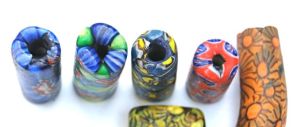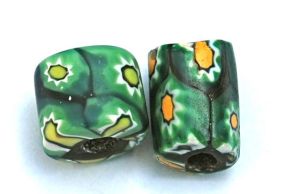Millefiori trade beads from Venice and their friends
July 17, 2010 4 Comments
Millefiori trade beads from Venice are pretty popular beads, both in West Africa, where they were shipped to in the late 19th, early 20th century, but also in Europe and North America. These ‘thousand flowers’ beads are made by placing slices of glass canes on a core of molten glass. In the last thirty years or so, the price of these beads has risen dramatically, with some of the rarer patterns going up to $30 or more per bead. But also the more common millefiori beads are usually several dollars each. It is no wonder that in places like China and Indoneasia, they started making copies of Venetian millefiori beads.
In this article I will go into the differences between the Venetian millefioris and the copies from India, Indonesia and China. I will give specific point that allow you to distinguish one from another, so you will not get fooled. I will show several pairs of beads: one Venetian, one replica. I will go into more detail of the Venetian millefiori beads in a later article.
Indian Beads
The Indians have been making beads for ages, and they really started making beads that resemble Venetian trade beads in bulk from 1980 onwards. The styles they make have only slightly changed since then. Some general ways to tell a bead is Indian is that the perforation is large, usually more than 3 mm. They are also often badly finished at the perforation with sharp edges. The millefiori beads are a quite a bit bigger than the Venetian ones. The colours and patterns are different from Venetian beads, and they are mostly darker. Some millefiori beads from India are mostly one colour, and only have a few cane slices on them. The slices are often stretched, placed without much thought to the overall look, or are badly cut. Most Indian made beads have a white residu in the perforation. Generally, once you have seen the comparison, it should not be too difficult to tell them apart.
On this picture you see an Indian bead on the left, and a Venetian one on the right.
These two pictures show three Indian beads and their perforations.
Indonesian Beads
Indonesia has quite a history in beadmaking, with Jatim beads that could be considered as ancient millefioris. However, they have not been making ‘Venetian style millefiori beads’ for that long. Most of these beads have been made no earlier than 1995, and after 2005, they are getting more varied and with better colours. Some of the beads are made to really resemple the patterns on their Venetian counterparts. Other beads are obviously inspired by the trade beads, but have their own colours, patterns and shapes. The two best ways to tell them apart is by their finish and their size. The glass used in most Indonesian Millefiori beads is slightly more transparant and has a somewhat greasy finish. They are also generally longer and wider than most Venetian beads.
These pictures show an Indonesian bead on the left, and a Venetian one on the right.
Below are all Indonesian beads
Chinese beads
The Chinese have almost perfected their replicas of Venetian millefiori beads. They specifically copy the patterns of the trade beads and try to come as close to the shape and colours as they can. The latest type of Chinese replica beads was first presented at the Tucson Bead shows in 2009. There are still some things that tell the beads apart. The way the ends are finished is neater than most Venetian beads. Also, most Chinese beads are cut at a straight angle, while a lot of the Venetian millefiori beads are cut at a slight angle.The colours are sometimes not quite right. Especially the yellow is too bright and slightly green, and the red colour is too bright as well. The finish is slightly different, also because they are new. However, this can easily be altered by sellers who want the beads to look older. Most beads show a bit of a white residue in the perforation. If you see the Chinese beads together, you will be able to tell them apart. However if they are mixed into a strand of Venetian millefioris, they are easy to miss.
In the pictures below, the Chinese one is on the left.
All Chinese beads:
A general note on replica millefiori beads. I think there is nothing wrong with replica beads, as long as they are sold as such. However sometimes they are sold as Venetian trade beads, either by people who do not know what they are selling, or by people aiming to make a profit. Have a good look at the differences, but also try to buy a few replicas, so you can study them in detail. Look at their shape, the colours, the finish, and simply feel them between your fingers. It will help you know what you are buying.
Finally, some mixed beads. Can you tell which one is from which country?
















